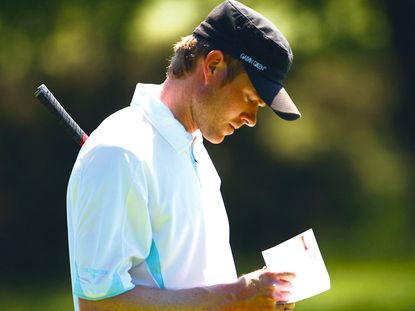Is Competition Scratch Score (CSS) fair?
Is CSS the best system? Are there issues? What are the alternatives?


Competition Scratch Score is the benchmark score calculated for each amateur tournament round in the UK. But how many understand it, and are claims that it's not always fair justified?
Competition Scratch Score is the benchmark score calculated for each amateur tournament round in the UK. But how many understand it, and are claims that it's not always fair justified?
A key objective for many golfers is to maintain or better their handicaps. Golf is essentially an individual game in which you must set individual goals. For those who play regularly in club competitions there’s no greater satisfaction than achieving a handicap reduction or battling to avoid the dreaded 0.1 increase. To achieve this sense of accomplishment we must either beat the Competition Scratch Score (CSS) for the day or finish within the appropriate ‘buffer zone’ of the CSS for our handicap category.
Most who strive to maintain an accurate handicap will be able to recall times when they’ve felt their performance has not resulted in satisfactory handicap ramifications. How many times each week is the shout of, “How on earth is CSS xx?” heard in clubhouses up and down the country.
The CSS is computed via a highly researched and complicated system that strives to produce the most realistic target score for a competition on any given day. In the main, the system is effective and does a good job of reflecting playing conditions. But, a common complaint about the CSS is that its calculation is based on the performance of the field, so success or failure against CSS depends partly on the performance of others. Is that fair? Is there an alternative?
To begin with, here’s a synopsis of how CSS is calculated under the Council of National Golf Unions (CONGU’s) Unified Handicapping System (UHS).
Each course has a Standard Scratch Score (SSS) allocated by its Union. This score is a measure of the difficulty of a course in normal, mid-season playing and weather conditions. It takes into account a variety of factors including length, terrain, out of bounds, hazards, green complexity and more. The most challenging courses will generally have an SSS above the par of the course; shorter and more straightforward tracks may have an SSS below par. The objective is to achieve consistency in difficulty. Handicap golfers should face a similar challenge playing to SSS over a wide range of UK courses. The SSS is the base number for calculating CSS.
Get the Golf Monthly Newsletter
Subscribe to the Golf Monthly newsletter to stay up to date with all the latest tour news, equipment news, reviews, head-to-heads and buyer’s guides from our team of experienced experts.
For each competition, a CSS is established. It’s designed to reflect the playing conditions on the day. The following calculations are made via a computer programme (although some clubs still do the sums manually) after the last card is handed in.
Firstly, the make-up of the field is established based on the percentage of players in each handicap category (excluding category 4 for men, though this will change from January 2016, and category 5 for ladies). Then you must work out the percentage of the field who have returned nett scores within their respective buffer zones or better, so category 1 SSS +1, category 2 SSS +2, category 3 SSS +3.
Tables are used to establish if the CSS will move from SSS, based on those percentages. If a suitably low percentage of players have met or bettered their buffer zones, CSS may go up (it can climb up to three above SSS before a round becomes ‘reduction only’); if a high percentage has met or bettered buffer, CSS can drop one below SSS.
Related: explaining the CONGU handicapping changes
The idea is that if the weather is bad, or the course set-up is particularly difficult, CSS should move up accordingly. If it’s a glorious day and the course is at its most forgiving, CSS may come down. It’s a sound concept, but it’s not bulletproof.
SSS is a score established objectively, based on set criteria applied consistently across every golf course. CSS is not so objective as it depends on two unpredictable variables – who is in the field and how they perform. Although CSS generally provides a reasonable reflection of playing conditions, there are instances where it can seem unfair.
For example, if a competition field comprises mainly older golfers – those with long-established handicaps, or even handicaps on the slide – a high percentage of the field will likely fail to make their buffer zone, regardless of conditions. CSS is bound to go up. A player in this field who performs competently and matches SSS may receive a perhaps unwarranted handicap cut. Over time, if this is the norm at a club, that individual’s handicap could be driven down, making them uncompetitive in away tournaments.
Conversely, if a field contains a high proportion of young and improving players, or those on good form – a club championship qualifying round for example – then even in challenging conditions, a high percentage of the field is likely to match or better their buffer. This might mean CSS could come down, or remain lower than the playing conditions alone would suggest. Someone who has battled wind and rain to post a score could go up 0.1 due to the abnormally good performances of others. Is that fair?
Perhaps not, but what are the alternatives? Play against SSS no matter what? That certainly wouldn’t be fair in the UK as the weather plays such a huge part in difficulty. When the wind is blowing at 45mph on a cold October morning, there’d be little incentive to go out in the competition if you thought you’d have to match SSS.
The US Slope System then? It alters a player’s handicap according to the difficulty of a course, even taking into account what tees you play from. It’s very clever, but it still doesn’t consider the weather – something crucial in this country. We’d have to totally alter our handicap system to incorporate Slope rating and, although England Golf did move to a USGA course rating system from January 2014, it will take a very long time to complete the programme. So, even if we were to eventually adopt the Slope system, it would be many, many years from now.
How else then? Perhaps send the secretary out on an hourly basis armed with an anemometer, a Stimpmeter, a trueness meter and a ruler to measure the rough height? After collating all the information, he could then establish an objective, scientifically calculated alteration to SSS based on known variables. Hmmm. Not very realistic!
No, the performance of the competitors provides the most representative gauge of the playing conditions on a given day. Notwithstanding those few rogue instances described above where CSS can be unfairly skewed, the system generally provides a fair and reasonable target score. And the UHS does offer provision for handicap review and adjustment if a player’s handicap has become unrepresentative of ability. Given the vagaries of the British weather and the effect it can have on playing surfaces, the CSS provides a fair benchmark for competition golf in this country.

Fergus is Golf Monthly's resident expert on the history of the game and has written extensively on that subject. He is a golf obsessive and 1-handicapper. Growing up in the North East of Scotland, golf runs through his veins and his passion for the sport was bolstered during his time at St Andrews university studying history. He went on to earn a post graduate diploma from the London School of Journalism. Fergus has worked for Golf Monthly since 2004 and has written two books on the game; "Great Golf Debates" together with Jezz Ellwood of Golf Monthly and the history section of "The Ultimate Golf Book" together with Neil Tappin , also of Golf Monthly.
Fergus once shanked a ball from just over Granny Clark's Wynd on the 18th of the Old Course that struck the St Andrews Golf Club and rebounded into the Valley of Sin, from where he saved par. Who says there's no golfing god?
-
 'Gator Netting Is In Place' - Chevron Championship Venue Prepared For 'Safe' Winner's Jump
'Gator Netting Is In Place' - Chevron Championship Venue Prepared For 'Safe' Winner's JumpA tradition which began at the tournament's previous home could continue this year - if the champion is feeling brave enough...
By Jonny Leighfield Published
-
 New Balance 997 SL Golf Shoe Review
New Balance 997 SL Golf Shoe ReviewNew Balance produce some extremely stylish footwear and, in this review, Matt Cradock takes their spikeless 997 SL onto the course
By Matt Cradock Published
-
 7 Most Annoying Golf Playing Partners
7 Most Annoying Golf Playing PartnersWe showcase the seven most annoying playing partners that golfers can have the misfortune of teeing it up with!
By Sam Tremlett Published
-
 How To Clean Golf Clubs And Grips
How To Clean Golf Clubs And GripsIf you want to know how to clean golf clubs and grips, check out this step-by-step guide
By Sam Tremlett Published
-
 In Praise Of Golfing In Winter
In Praise Of Golfing In WinterFergus Bisset on why he enjoys playing golf through the winter months
By Fergus Bisset Published
-
 'Why Do Golfers Only Wear One Glove?' You Asked Google And We've Got The Answer...
'Why Do Golfers Only Wear One Glove?' You Asked Google And We've Got The Answer...You asked Google and we've got the answer...
By Roderick Easdale Published
-
 How To Regrip Golf Clubs
How To Regrip Golf ClubsKnowing how to regrip golf clubs means you can afford to replace them as and when they need replacing
By Joe Ferguson Published
-
 The 7 Scariest Shots in Golf
The 7 Scariest Shots in GolfWith Halloween creeping up, we have selected the 7 scariest shots in golf
By Neil Tappin Published
-
 17 Ways To Tell You're Obsessed With Golf
17 Ways To Tell You're Obsessed With GolfThe tell-tale signs that you are a true golf fanatic
By Roderick Easdale Published
-
 10 Of The Best Arnold Palmer Quotes
10 Of The Best Arnold Palmer QuotesHere we take a look at 10 of our favourite Arnold Palmer quotes
By Roderick Easdale Published